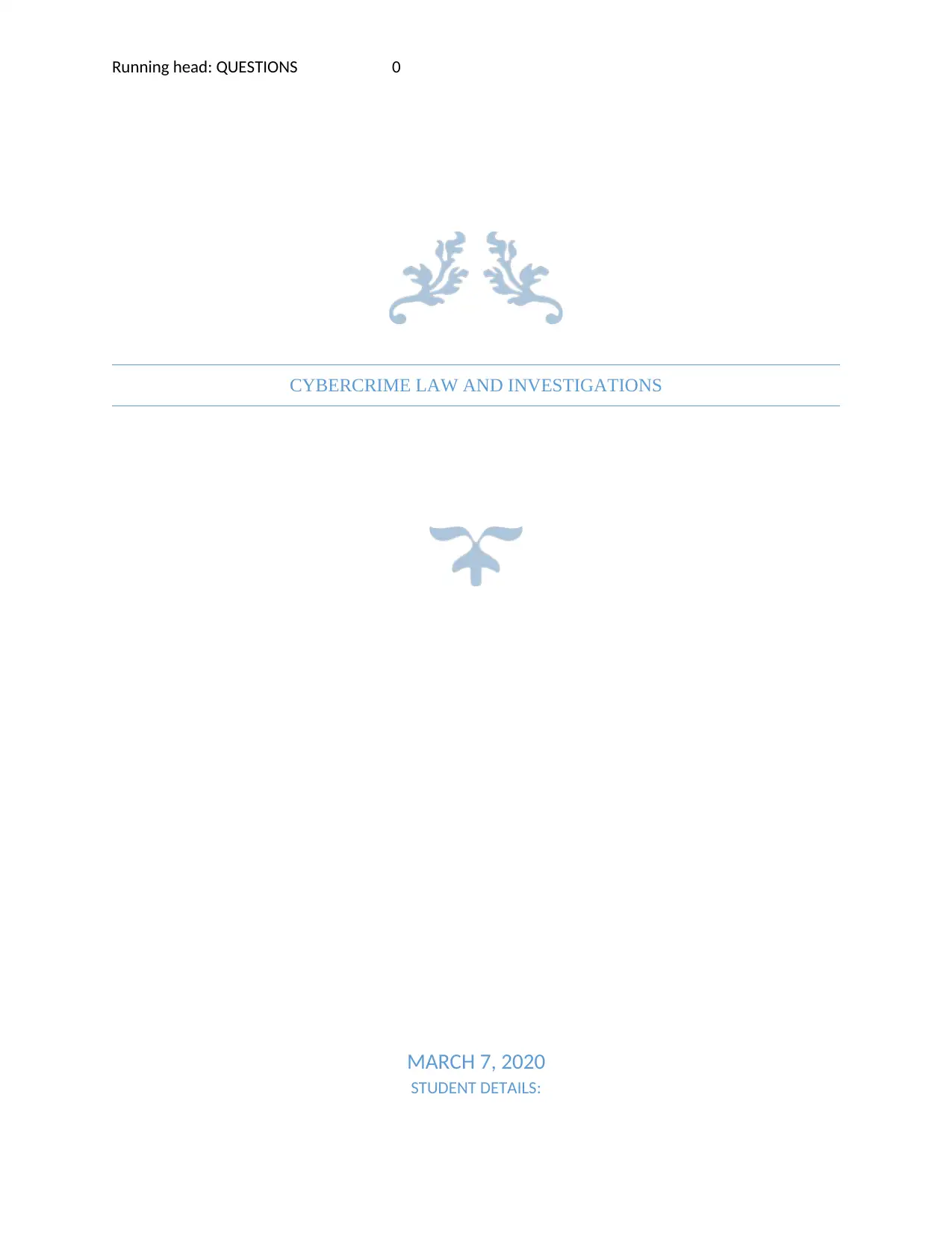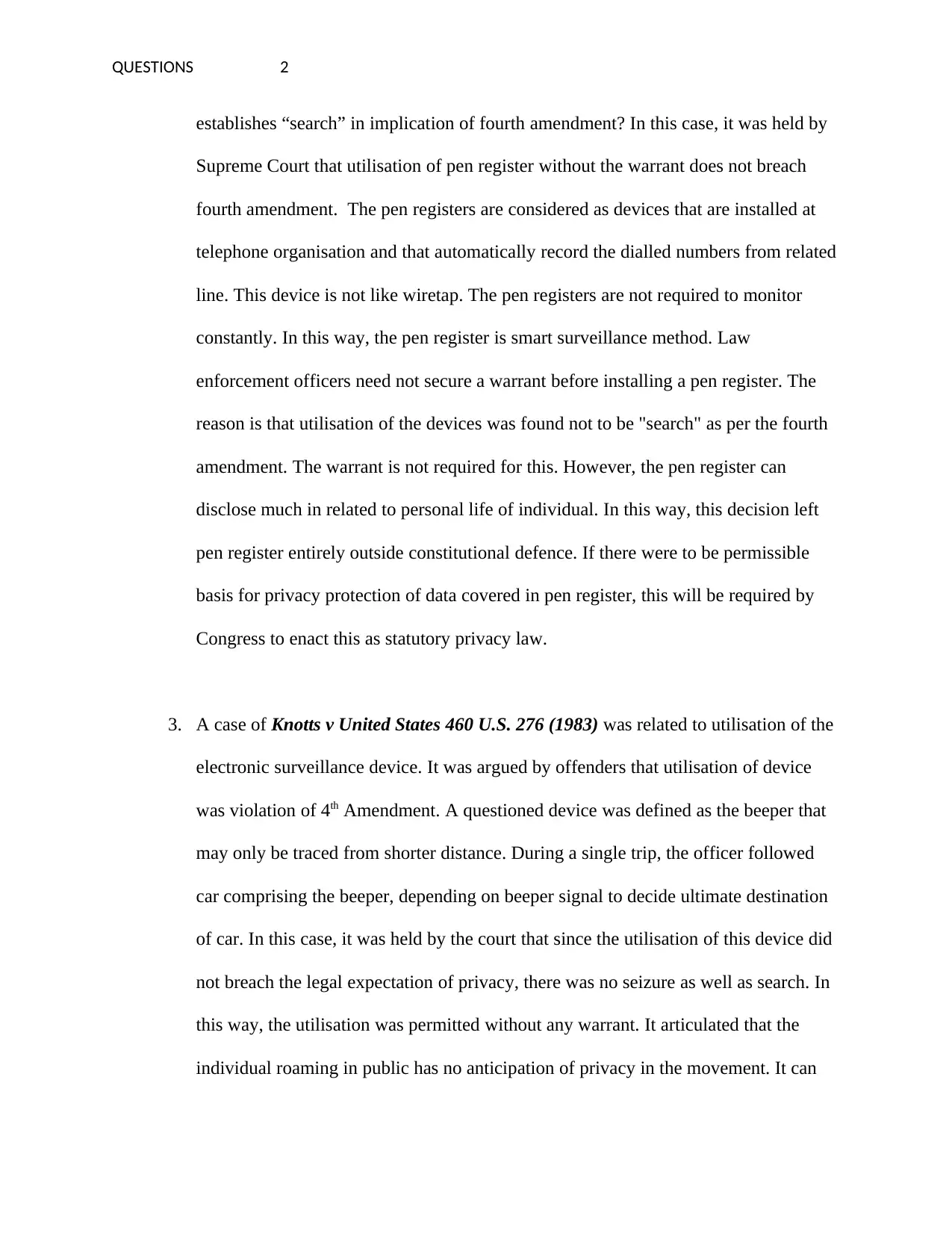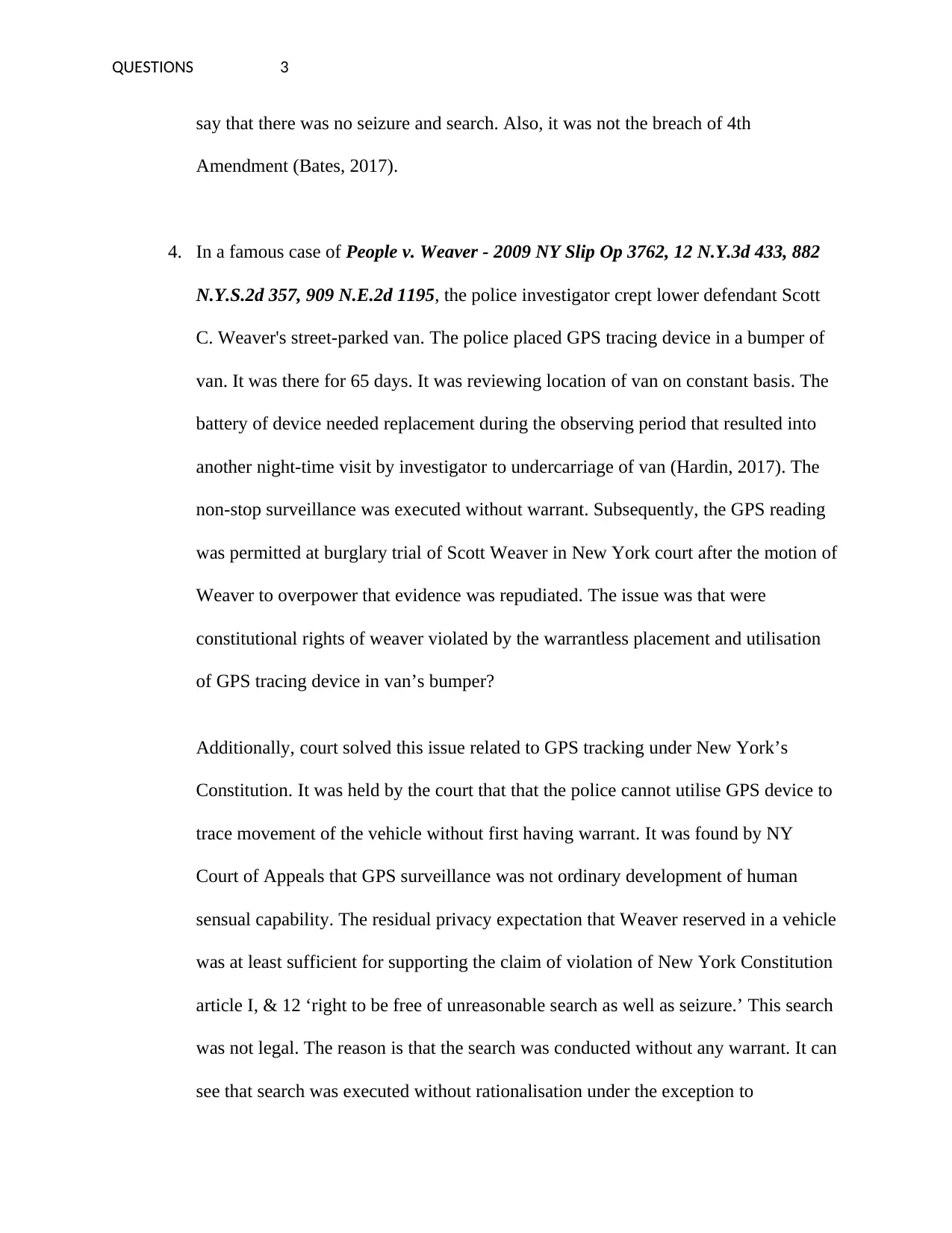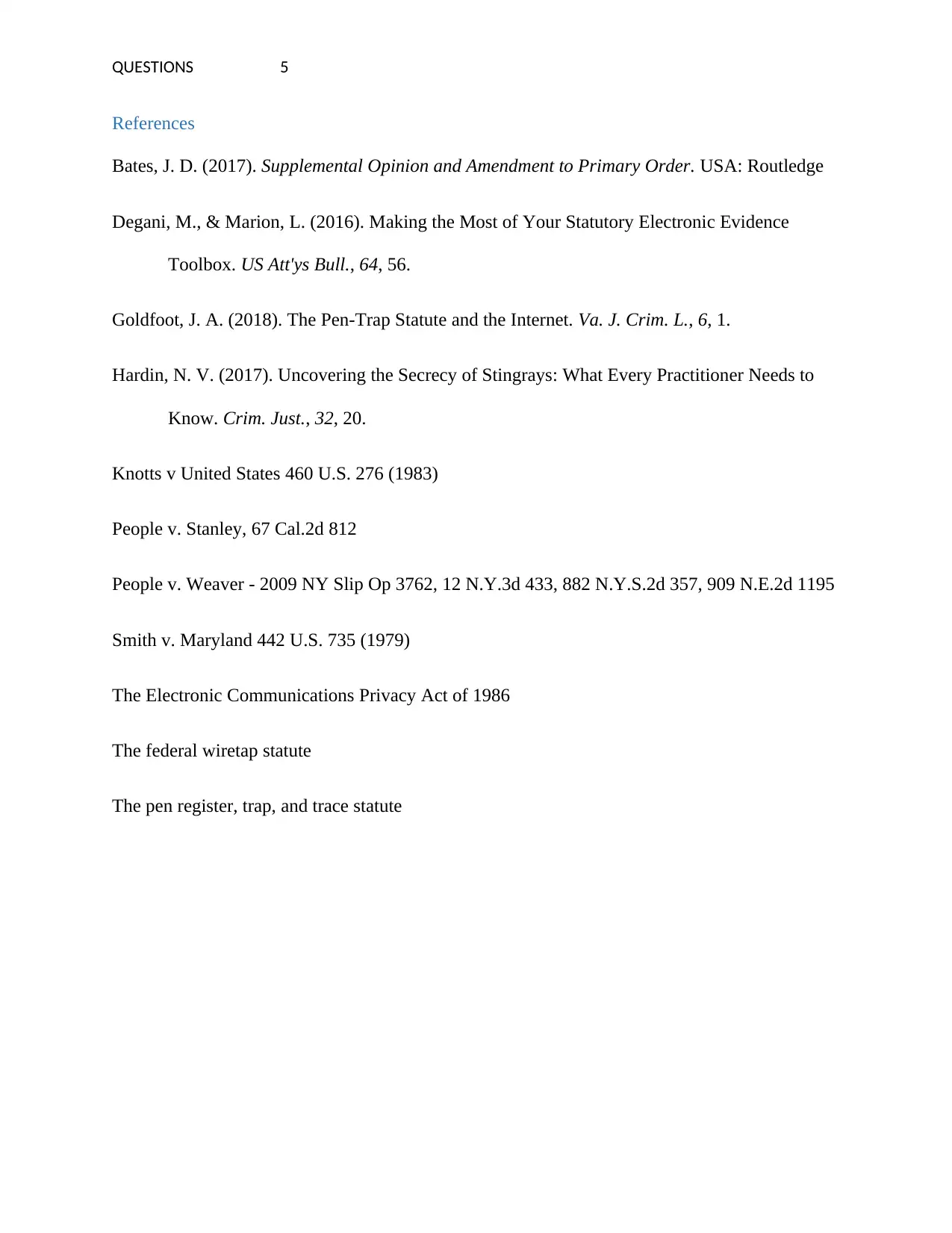Cybercrime Law and Investigations: Case Studies and Legal Precedents
VerifiedAdded on 2022/08/17
|6
|1485
|11
Homework Assignment
AI Summary
This assignment delves into the legal aspects of cybercrime, focusing on the use of surveillance technologies and their implications. It examines the functionalities of pen registers and trap and trace devices, the legal standards for their use, and the information they provide. The assignment analyzes key court cases, including Smith v. Maryland, Knotts v. United States, and People v. Weaver, to understand the Fourth Amendment implications of electronic surveillance, particularly concerning privacy rights and warrantless searches. It discusses the legal issues surrounding GPS tracking and the evolving interpretations of constitutional rights in the digital age. The assignment also explores the role of expert testimony in court, using People v. Stanley as an example to illustrate the significance of forensic evidence and potential biases in expert opinions. Overall, the assignment provides a comprehensive overview of cybercrime law, electronic surveillance, and the legal precedents that shape their application.

Running head: QUESTIONS 0
CYBERCRIME LAW AND INVESTIGATIONS
MARCH 7, 2020
STUDENT DETAILS:
CYBERCRIME LAW AND INVESTIGATIONS
MARCH 7, 2020
STUDENT DETAILS:
Paraphrase This Document
Need a fresh take? Get an instant paraphrase of this document with our AI Paraphraser

QUESTIONS 1
1. The pen register is considered as surveillance device that track phone number dialled
on outgoing phone call. In addition, the trap as well as trace tools track number
recognising incoming call. They are not required to disclose contents
of communication. Accordingly, the trap and trace devices as well as pen register are
very helpful in enforcing law and posing important issues related to privacy. There
are 3 main laws setting privacy standards for government interference of
communication and access to data of subscribers. These involve Electronic
Communications Privacy Act of 1986, federal wiretap statute as well as the pen
register and trap and trace statute that passed as part of ECPA. Pen register along with
trap and trace statute, passed as part of Electronic Communications Privacy Act, 18
USC 3121 et seq., regulating real-time interruption of "number dialled or otherwise
transmitted on phone lines to which device is connected." The standard is that of
rubber stamp. Additionally, if provisions of trap and trace as well as pen register are
rendered countrywide result, then it is not required to be applied on each order. There
should certain requirements that the claimant clarify to the satisfaction of judge why
consultant is required to do investigation across jurisdictional line (Goldfoot, 2018).
2. In the case of Smith v. Maryland 442 U.S. 735 (1979), the female was deprived. The
robbery got frightening calls from thief. To learn the recognition, the telephone
company connected pen register at the office for recording numbers dialled from the
home of robber, at demand of forces. The police force did not get warrant. The
problem is that whether connection along with utilisation of the pen register
1. The pen register is considered as surveillance device that track phone number dialled
on outgoing phone call. In addition, the trap as well as trace tools track number
recognising incoming call. They are not required to disclose contents
of communication. Accordingly, the trap and trace devices as well as pen register are
very helpful in enforcing law and posing important issues related to privacy. There
are 3 main laws setting privacy standards for government interference of
communication and access to data of subscribers. These involve Electronic
Communications Privacy Act of 1986, federal wiretap statute as well as the pen
register and trap and trace statute that passed as part of ECPA. Pen register along with
trap and trace statute, passed as part of Electronic Communications Privacy Act, 18
USC 3121 et seq., regulating real-time interruption of "number dialled or otherwise
transmitted on phone lines to which device is connected." The standard is that of
rubber stamp. Additionally, if provisions of trap and trace as well as pen register are
rendered countrywide result, then it is not required to be applied on each order. There
should certain requirements that the claimant clarify to the satisfaction of judge why
consultant is required to do investigation across jurisdictional line (Goldfoot, 2018).
2. In the case of Smith v. Maryland 442 U.S. 735 (1979), the female was deprived. The
robbery got frightening calls from thief. To learn the recognition, the telephone
company connected pen register at the office for recording numbers dialled from the
home of robber, at demand of forces. The police force did not get warrant. The
problem is that whether connection along with utilisation of the pen register

QUESTIONS 2
establishes “search” in implication of fourth amendment? In this case, it was held by
Supreme Court that utilisation of pen register without the warrant does not breach
fourth amendment. The pen registers are considered as devices that are installed at
telephone organisation and that automatically record the dialled numbers from related
line. This device is not like wiretap. The pen registers are not required to monitor
constantly. In this way, the pen register is smart surveillance method. Law
enforcement officers need not secure a warrant before installing a pen register. The
reason is that utilisation of the devices was found not to be "search" as per the fourth
amendment. The warrant is not required for this. However, the pen register can
disclose much in related to personal life of individual. In this way, this decision left
pen register entirely outside constitutional defence. If there were to be permissible
basis for privacy protection of data covered in pen register, this will be required by
Congress to enact this as statutory privacy law.
3. A case of Knotts v United States 460 U.S. 276 (1983) was related to utilisation of the
electronic surveillance device. It was argued by offenders that utilisation of device
was violation of 4th Amendment. A questioned device was defined as the beeper that
may only be traced from shorter distance. During a single trip, the officer followed
car comprising the beeper, depending on beeper signal to decide ultimate destination
of car. In this case, it was held by the court that since the utilisation of this device did
not breach the legal expectation of privacy, there was no seizure as well as search. In
this way, the utilisation was permitted without any warrant. It articulated that the
individual roaming in public has no anticipation of privacy in the movement. It can
establishes “search” in implication of fourth amendment? In this case, it was held by
Supreme Court that utilisation of pen register without the warrant does not breach
fourth amendment. The pen registers are considered as devices that are installed at
telephone organisation and that automatically record the dialled numbers from related
line. This device is not like wiretap. The pen registers are not required to monitor
constantly. In this way, the pen register is smart surveillance method. Law
enforcement officers need not secure a warrant before installing a pen register. The
reason is that utilisation of the devices was found not to be "search" as per the fourth
amendment. The warrant is not required for this. However, the pen register can
disclose much in related to personal life of individual. In this way, this decision left
pen register entirely outside constitutional defence. If there were to be permissible
basis for privacy protection of data covered in pen register, this will be required by
Congress to enact this as statutory privacy law.
3. A case of Knotts v United States 460 U.S. 276 (1983) was related to utilisation of the
electronic surveillance device. It was argued by offenders that utilisation of device
was violation of 4th Amendment. A questioned device was defined as the beeper that
may only be traced from shorter distance. During a single trip, the officer followed
car comprising the beeper, depending on beeper signal to decide ultimate destination
of car. In this case, it was held by the court that since the utilisation of this device did
not breach the legal expectation of privacy, there was no seizure as well as search. In
this way, the utilisation was permitted without any warrant. It articulated that the
individual roaming in public has no anticipation of privacy in the movement. It can
⊘ This is a preview!⊘
Do you want full access?
Subscribe today to unlock all pages.

Trusted by 1+ million students worldwide

QUESTIONS 3
say that there was no seizure and search. Also, it was not the breach of 4th
Amendment (Bates, 2017).
4. In a famous case of People v. Weaver - 2009 NY Slip Op 3762, 12 N.Y.3d 433, 882
N.Y.S.2d 357, 909 N.E.2d 1195, the police investigator crept lower defendant Scott
C. Weaver's street-parked van. The police placed GPS tracing device in a bumper of
van. It was there for 65 days. It was reviewing location of van on constant basis. The
battery of device needed replacement during the observing period that resulted into
another night-time visit by investigator to undercarriage of van (Hardin, 2017). The
non-stop surveillance was executed without warrant. Subsequently, the GPS reading
was permitted at burglary trial of Scott Weaver in New York court after the motion of
Weaver to overpower that evidence was repudiated. The issue was that were
constitutional rights of weaver violated by the warrantless placement and utilisation
of GPS tracing device in van’s bumper?
Additionally, court solved this issue related to GPS tracking under New York’s
Constitution. It was held by the court that that the police cannot utilise GPS device to
trace movement of the vehicle without first having warrant. It was found by NY
Court of Appeals that GPS surveillance was not ordinary development of human
sensual capability. The residual privacy expectation that Weaver reserved in a vehicle
was at least sufficient for supporting the claim of violation of New York Constitution
article I, & 12 ‘right to be free of unreasonable search as well as seizure.’ This search
was not legal. The reason is that the search was conducted without any warrant. It can
see that search was executed without rationalisation under the exception to
say that there was no seizure and search. Also, it was not the breach of 4th
Amendment (Bates, 2017).
4. In a famous case of People v. Weaver - 2009 NY Slip Op 3762, 12 N.Y.3d 433, 882
N.Y.S.2d 357, 909 N.E.2d 1195, the police investigator crept lower defendant Scott
C. Weaver's street-parked van. The police placed GPS tracing device in a bumper of
van. It was there for 65 days. It was reviewing location of van on constant basis. The
battery of device needed replacement during the observing period that resulted into
another night-time visit by investigator to undercarriage of van (Hardin, 2017). The
non-stop surveillance was executed without warrant. Subsequently, the GPS reading
was permitted at burglary trial of Scott Weaver in New York court after the motion of
Weaver to overpower that evidence was repudiated. The issue was that were
constitutional rights of weaver violated by the warrantless placement and utilisation
of GPS tracing device in van’s bumper?
Additionally, court solved this issue related to GPS tracking under New York’s
Constitution. It was held by the court that that the police cannot utilise GPS device to
trace movement of the vehicle without first having warrant. It was found by NY
Court of Appeals that GPS surveillance was not ordinary development of human
sensual capability. The residual privacy expectation that Weaver reserved in a vehicle
was at least sufficient for supporting the claim of violation of New York Constitution
article I, & 12 ‘right to be free of unreasonable search as well as seizure.’ This search
was not legal. The reason is that the search was conducted without any warrant. It can
see that search was executed without rationalisation under the exception to
Paraphrase This Document
Need a fresh take? Get an instant paraphrase of this document with our AI Paraphraser

QUESTIONS 4
requirement of warrant. For that reason, the motion of weaver to overwhelm should
not be repudiated.
5. Testifying in court is inspiring experience. The beginners who are not familiar with
legal atmosphere can get insecurity in relation to various facets of the testimony.
These aspects can be related to their clothes as well as language. Even knowledgeable
expert witness can be disconcerted by cross investigation of skilled advocate. The
People v. Stanley, 67 Cal.2d 812 case is very good example of expert witness or
testimony. In this case, it can see that there is great purpose to be alarmed related to
operations of related bias. Additionally, testament provided by policeman witness,
such as forensic officer, at hearing or preliminary trial advices that best contract of
data was being shared between forensic administrative as well as the investigative
officer. The discussion seems to have been made on a view that it was forthright
method. On the basis of these discussed points, for instance, bloodstain pattern
forecasters created opinion that she did not require to see scenes or car. In addition,
Stanley did not require rendering the report as per the views of bloodstain pattern
analyst. At hearing, it was critical to determine the relative body position of victim as
well as accused because of contradiction amongst Stanley and eyewitness, and for the
reason of hang fire theory. In a case when bloodstain method forecaster had reviewed
bloodstain methods in person when scenes were complete, then much more data will
likely have been obtainable to panel. Compounding misunderstanding, forensic
pathologist who may also have shanty lights upon position of body, was not
considered for testifying (Degani & Marion, 2016).
requirement of warrant. For that reason, the motion of weaver to overwhelm should
not be repudiated.
5. Testifying in court is inspiring experience. The beginners who are not familiar with
legal atmosphere can get insecurity in relation to various facets of the testimony.
These aspects can be related to their clothes as well as language. Even knowledgeable
expert witness can be disconcerted by cross investigation of skilled advocate. The
People v. Stanley, 67 Cal.2d 812 case is very good example of expert witness or
testimony. In this case, it can see that there is great purpose to be alarmed related to
operations of related bias. Additionally, testament provided by policeman witness,
such as forensic officer, at hearing or preliminary trial advices that best contract of
data was being shared between forensic administrative as well as the investigative
officer. The discussion seems to have been made on a view that it was forthright
method. On the basis of these discussed points, for instance, bloodstain pattern
forecasters created opinion that she did not require to see scenes or car. In addition,
Stanley did not require rendering the report as per the views of bloodstain pattern
analyst. At hearing, it was critical to determine the relative body position of victim as
well as accused because of contradiction amongst Stanley and eyewitness, and for the
reason of hang fire theory. In a case when bloodstain method forecaster had reviewed
bloodstain methods in person when scenes were complete, then much more data will
likely have been obtainable to panel. Compounding misunderstanding, forensic
pathologist who may also have shanty lights upon position of body, was not
considered for testifying (Degani & Marion, 2016).

QUESTIONS 5
References
Bates, J. D. (2017). Supplemental Opinion and Amendment to Primary Order. USA: Routledge
Degani, M., & Marion, L. (2016). Making the Most of Your Statutory Electronic Evidence
Toolbox. US Att'ys Bull., 64, 56.
Goldfoot, J. A. (2018). The Pen-Trap Statute and the Internet. Va. J. Crim. L., 6, 1.
Hardin, N. V. (2017). Uncovering the Secrecy of Stingrays: What Every Practitioner Needs to
Know. Crim. Just., 32, 20.
Knotts v United States 460 U.S. 276 (1983)
People v. Stanley, 67 Cal.2d 812
People v. Weaver - 2009 NY Slip Op 3762, 12 N.Y.3d 433, 882 N.Y.S.2d 357, 909 N.E.2d 1195
Smith v. Maryland 442 U.S. 735 (1979)
The Electronic Communications Privacy Act of 1986
The federal wiretap statute
The pen register, trap, and trace statute
References
Bates, J. D. (2017). Supplemental Opinion and Amendment to Primary Order. USA: Routledge
Degani, M., & Marion, L. (2016). Making the Most of Your Statutory Electronic Evidence
Toolbox. US Att'ys Bull., 64, 56.
Goldfoot, J. A. (2018). The Pen-Trap Statute and the Internet. Va. J. Crim. L., 6, 1.
Hardin, N. V. (2017). Uncovering the Secrecy of Stingrays: What Every Practitioner Needs to
Know. Crim. Just., 32, 20.
Knotts v United States 460 U.S. 276 (1983)
People v. Stanley, 67 Cal.2d 812
People v. Weaver - 2009 NY Slip Op 3762, 12 N.Y.3d 433, 882 N.Y.S.2d 357, 909 N.E.2d 1195
Smith v. Maryland 442 U.S. 735 (1979)
The Electronic Communications Privacy Act of 1986
The federal wiretap statute
The pen register, trap, and trace statute
⊘ This is a preview!⊘
Do you want full access?
Subscribe today to unlock all pages.

Trusted by 1+ million students worldwide
1 out of 6
Your All-in-One AI-Powered Toolkit for Academic Success.
+13062052269
info@desklib.com
Available 24*7 on WhatsApp / Email
![[object Object]](/_next/static/media/star-bottom.7253800d.svg)
Unlock your academic potential
Copyright © 2020–2025 A2Z Services. All Rights Reserved. Developed and managed by ZUCOL.
